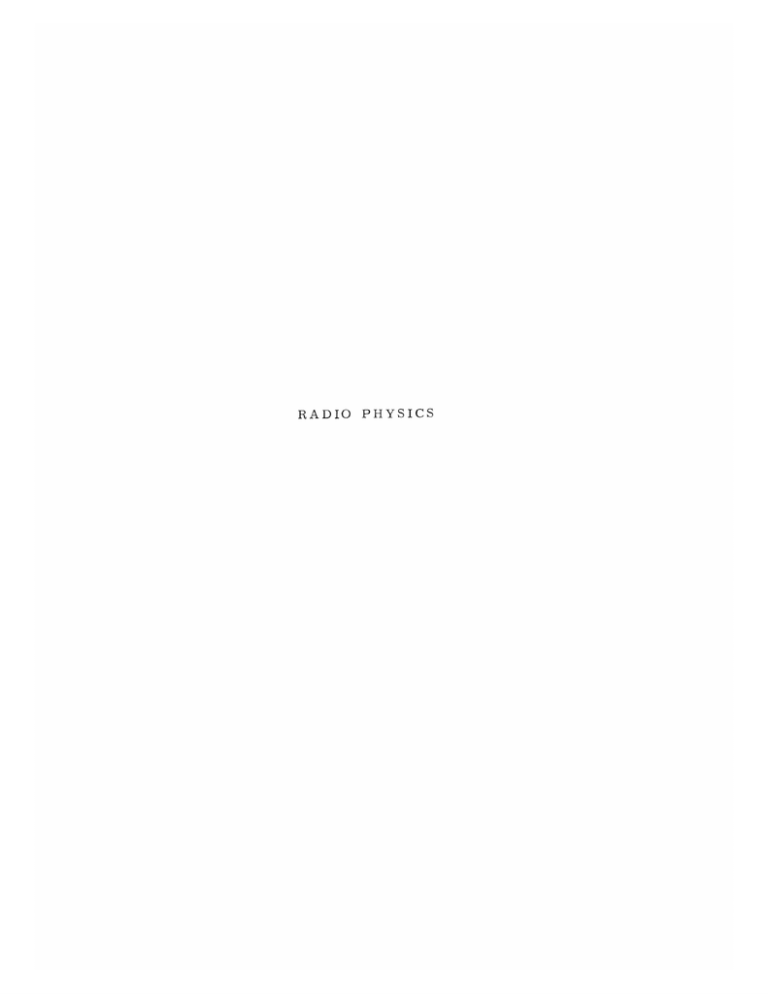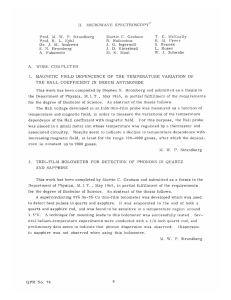RADIO PHYSICS
advertisement

RADIO PHYSICS I. MICROWAVE R. J. J. J. Prof. M. W. P. Strandberg Prof. R. L. Kyhl Dr. J. M. Andrews A. Fukumoto A. A COMPUTER SOLUTION SPECTROSCOPY S. W. J. A. Huibonhoa G. Ingersoll D. Kierstead W. Mayo Reznek J. Schwabe C. Shah Zobrist FOR ALLOWED ENERGY BANDS FOR PERIODIC POTENTIALS arbitrary periodic an Given Schrddinger's a, potential of period we know that a solution of equations will be absolutely periodic if it satisfies periodic boundary conditions. (x+a) = (x) d@ d d- (x+a) = dr (x) Also, a solution will be half-periodic, that is, it will repeat every two periods, if it sat- isfies the following periodic boundary conditions. 4(x+a) = -4(x) d d ( x+a) - (x) Periodic and half-periodic solutions occur at discrete energies. Moreover, the energies depend upon the initial conditions of the solution. As an example of this, consider the solution of the wave equation for a potential consisting of a periodic delta function (a) t V t .\./ (b) t I tv I The delta function does not affect the electron in (b),since it is at a node of the solution. Hence, the electron in (a) has higher energy. The program has been written for a PDP-1 computer controlled by teletype. of 512 registers is used to store one period of the potential. A field Subroutines are included for placing the potentials on this field. The solution, when found, is stored on another field of 512 registers. and solution The potential may be displayed on the PDP-1 oscilloscope. This work was supported in part by Purchase Order DDL BB- 107 with Lincoln Laboratory, a center for research operated by Massachusetts Institute of Technology, with the support of the U.S. Air Force under Contract AF 19(608)-500. QPR No. 75 100 v7 v8 v9 v2 vl v3 v4 v5 v6 1i -i mm mm m m -m -m -m. -Um -m m -U. -El mE 1m _mm, -- -El -El -El 0.1 -El ------ m m INDICATES THE MAXIMUM HEIGHT OF THE POTENTIAL FUNCTION 0.01 L Fig. I-1. QPR No. 75 Allowed energy bands for an electron in a one-dimensional solid for various potentials. v2 - SQUARE WELL vl - BARRIER 1/ 4 A 0.5925 8.521 -0.013 - 7.941 1/4 x v4 - COULOMB v3 - COULOMB (1 1 .50 - .50 -6.764 3.367 1/16 1/4 v v6 - TRIANGULAR v5 - SINUSOIDAL 3.061 -1.810 DELTA FUNCTIONS v8: v = - 4682 ev o v = - 1560 ev v9: v = -390 ev v7: Fig. 1-2. QPR No. 75 1/ 256 X 0 The potentials used by the program. (All cells are 2 A long; energy in electron volts.) Fig. I-3. Four periods of square well. Electron at 1. 81 ev. Electron is in an allowed band. Fig. I-4. Fig. 1-5. Periodic solution for sinusoidal potential. 1. 23 ev. Fig. I-6. Fig. 1-7. Periodic solution for Coulomb (v4). . 094 ev. QPR No. 75 Four periods of square well. Electron at . 81 ev. Electron is in a forbidden band. Periodic solution for delta function (v7). Fig. 1-8. .347 ev. Half-periodic solution for square well. 0. 90 ev. (I. MICROWAVE SPECTROSCOPY) If an electron energy is typed in and the program is started, the computer will find a solution with the end heights matched. (x+a) = (x) or .(x+a) = - (x) Upon command, the program increments the energy upwards until the end slopes are matched. d4 d(x+a) = d4 (x) Thus all of the values of the periodic and half-periodic solutions can be found one by one. Two sets of initial conditions were used. 4'(0) = '(0) = 0 ' or (0)= o (0)= o The energies found in this manner were taken to be edges of the allowed and forbidden bands for an electron in a one-dimensional solid. for the various potentials shown in Fig. 1-2. The results are plotted in Fig. I-i The energies have been chosen so that the highest energy of the first allowed bands will coincide (except for potentials v4 and v6). The Coulomb potentials are actually the lattice sum of several neighboring Coulomb potentials. These results were confirmed by another section of the program which extended the solution over several periods of the potential (Figs. I-3 and 1-4). tions are shown in Figs. 1-5, 1-6, 1-7, Some periodic solu- and 1-8. The program is useful for demonstrating the properties of a wave function in one dimension, and is capable of handling any symmetric potential. A. Zobrist, M. W. P. B. INCOHERENT PHONON PROPAGATION IN ANISOTROPIC Strandberg MEDIA The usual ultrasonic phonon experiment involves piezoelectric (or magnetostrictive) transducers oriented and cut in such a way that their surfaces produce wave surfaces of constant phase. and respond to Such configurations are chosen to enhance the gener- ation of coherent phonons of some desired mode, and the detectors are relatively insen- sitive to phonons whose wave vectors deviate significantly from the normal to their surface. The direction of travel of a phonon in an anisotropic medium is not generally colinear QPR No. 75 (I. MICROWAVE SPECTROSCOPY) with its wave vector. In a crystal the specific directions in which the ultrasonic wave vector and the Poynting vector are colinear are termed pure-mode axes. For example, if the wave vector of a phonon propagating in a-quartz is not directed along a pure-mode axis, its direction of travel can deviate up to 500 from its wave vector. 1 Such effects have been observed in experiments where the transducer diameters are small in comparison with their separation, yet are large in comparison with the ultrasonic wavelength. The experimental configuration is sketched in Fig. 1-9. R d Here, no signal is R2 ANISOTROPIC PROPAGATION MEDIUM k X Fig. 1-9. Ultrasonic propagation in an anisotropic medium. The ultrasonic Poynting vector S makes an angle 8 with the wave vector k. detected at the receiving transducer R 1, which is directly opposite the transmitting transducer X. However, a large signal is detected at the receiving transducer R 2 . (The ultrasonic Poynting vector S makes an angle 0 with the wave vector k.) Phase velocities are determined by the quotient of the component of the transducer separation in the direction of the wave vector (i. e., the distance d in Fig. I-9) and the elapsed time. The velocity of the flow of ultrasonic energy, on the other hand, is greater by the factor sec 8. v E = Vp sec 6 (1) A small heating element is capable of producing simultaneously the entire phonon spectrum, characteristic of some absolute temperature T, that can be propagated within a crystal. If a small bolometer is attached at another point on the crystal, all phonons whose Poynting vectors lie within the subtended solid angle can be detected, regardless of the orientation of their wave vectors. In general, the double mode-dependence of Eq. 1 complicates the theoretical analysis for arbitrary propagation directions in typical anisotropic media. If observations were to be made within very small solid angles cen- tered about a pure-mode axis, however, most of the data could be interpreted in terms of the well-known velocities characteristic of the axis. The x axis of a-quartz is a pure-mode axis for both longitudinal and transverse phonons. Thus, as the solid angle subtended by a bolometer approaches zero at the x axis, QPR No. 75 (I. MICROWAVE SPECTROSCOPY) three pulses should be detected whose energy velocities approach the phase velocities characteristic of x-axis phonon propagation (v =5. 75, v 1 t=5. 18, v2t=3. 36 km/sec). however, This, does not rule out the existence of "extra" pulses caused by other modes whose Poynting vectors also happen to lie along the x axis. vector diagram for transverse waves in a-quartz, An examination of the energy-flow indicates that calculated by Farnell, phonons whose wave vectors intercept the unit sphere somewhere in the region near 0 = 700 and c = 100 might contribute to energy detected on the x axis. 3 An "extra" pulse has been observed by von Gutfeld and Nethercot for this orientation of a-quartz, although the angle subtended by their detector was not stated. Farnell's diagram shows that a detector that subtends a half-angle of 25. 50 will pick up the transverse mode whose wave vector intercepts the unit sphere at 0 = 900 and 4 = 400. Since von Gutfeld and Nethercot did not mention the angle subtended by the bolometer in their x-cut quartz experiment, the question concerning the existence of "extra" modes propagating along the x-axis in a-quartz remains open. J. M. Andrews, Jr. References 1. G. W. Farnell, Can. J. 2. M. F. 3. R. J. QPR No. 75 Markham, Phys. 39, Brit. J. 65 (1961). Appl. Phys., Suppl. No. von Gutfeld and A. H. Nethercot, Jr., 6, S56 (1957). Phys. Rev. Letters 12, 641 (1964).




